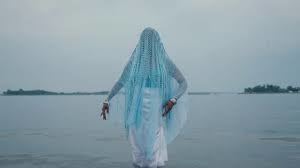It’s hard to describe exactly what went down in class. Here’s a very short recap (but it won’t do it justice) before I reflect on the exercise itself:
I hit play, and opened with bisexual and pansexual futurity in Janelle Monáe’s “PYNK,” and then it only got more wonderful from there. Zee amped up the body positivity with Machito & Graciela’s “Si Si, No No” and Stephania brought us to gender fluidity and the gendered and racialized beauty standards of Puerto Rico using Bad Bunny and his song “Caro” as an example. Solange introduced us to Princess Nokia’s amazing song and music video, “Brujas,” a reflection of Princess Nokia’s own involvement in brujería and her inclusion of Afro-Latina narratives, and I’m now totally obsessed. Tiffany, talking about “Lost Ones” and Lauryn Hill’s big Grammy sweep with her album Miseducation, asked us how we define winning and who gets to choose what “winning” is. Dave discussed police violence against Black youth using Nas’ “Cops Shot the Kid” (which I’ve been singing and thinking about since class). Cathy “Cat” Davidson remixed Miseducation with her own work on The New Education, talking about miseducation and race, and “the race to miseducation.” Chandni broke down M.I.A.’s history as a displaced person, reminding us (with “Borders” playing in the background) that “freedom is contingent on the unfreedom of others.” Diana introduced us to A Tribe Called Red’s “The Virus,” which tied together many of the themes throughout our Critical Karaoke session, and presented her research on artist and activist Saul Williams.
What I loved most about bringing Critical Karaoke into the graduate classroom was that I learned so much about everyone in the classroom. I learned about their interests (musical and academic), about their personal investments in certain artists and ideas related to the class (“Mediating Race“), and their methods for critically approaching different media forms (e.g., aural, visual, audiovisual, digital). The best part of the conversation that followed (we were all a little saturated by so much aural and visual stimulation SO uncommon in academic settings that it took a moment to collect ourselves) was learning why each person chose the song they did (and not something else) and hearing about the process behind each presentation. If I were to do this again, the first question I would ask is “Why did you choose this song and not something else?”
I’ve never felt time fly the way it did in this session–I was still asking questions at 4PM when it was time to leave because I completely forgot about the time! If you want to see a mini Critical Karaoke session, come to our FI conference on April 9th, “Race and Its Futures,” where a few students from class will present in a mini encore tour of what we did in class.
Many thanks to Professors Davidson and Gates for trusting me with this class session, and for all our participants who bravely prepared their performances for class!

2 responses to “A Quick Recap of Bringing Critical Karaoke into the Classroom”
Christina, thank you for facilitating such a great class! Chandni’s comments about wanting to discuss so many different components with her video selection, really resonated with me. I’ve watched “Brujas” quite a bit, but it was a different experience of having to academically break down the music video versus me casually enjoying the video. I felt as if the 3:00+ minutes I had was not enough time, but I got as much information out as possible. Now that I’ve run through it, I know some of the things to expand upon and to take out.
What I really enjoyed was everyone’s presentation style. A few folks spoke for a majority of their videos, others let the music video and lyrics speak for themselves, while a few actually brought the lyrics into their own scripts. I think aside from learning about everyone’s different musical selections, I got to experience different presentation and pedagogical styles, which was awesome to see. Great job everyone!
You did a brilliant job, Christina, and your own critical karaoke was beautiful, important, moving, fierce. And every single student took this seriously, with intent, and did a great job. Fabulous.
Here’s a p.s. to my Critical Karaoke. If I had had 4.27 minutes– instead of 3.27 minutes for Lauryn Hill’s freestyle remix at the Apollo of Drake’s “Nice For What” that extensively samples “Ex Factor” from her only solo album, “The Miseducation of Lauryn Hill”–I would have added this post script about “karaoke” itself:
CRITICAL KARAOKE:
Critical: from the Latin criticus, discernment by way of the Middle English critical, censorious, inclined to find fault,” from critic.
Sound like school yet? Miseducation. Missed education.
It ain’t worth it. It ain’t worth it.
Now. Karaoke.
Karaoke means empty orchestra. It’s an adaptation of a Japanese phrase remixing the Japanese word Karappo (empty:
空っぽ) with the English “orchestra” as translated into Japanese alphabet for western words: orchestra or Okesutura: vowel, consonant, vowel, consonant, forty-six basic katakana phonetic remixes of 50,000 Chinese kanji characters.
Karappo Okesutura to Karaoke to Carry-Oki.
That’s the remix.
How can I, explain myself?
To me, that is what active learning is: constantly taking the parts and the traditions and remixing them in new ways that are not only relevant to students but where students are offered the mic, given the permission to sing the melody over a background of mixed and remixed parts.
This is why I chose to do my own Critical Karaoke against the “okesutura” of Lauryn Hill’s reclaiming and freestyle remixing of a remix. So it goes.